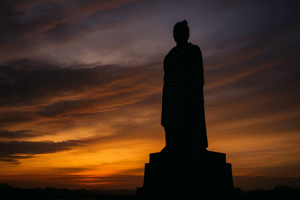Fun fact: the ancient Egyptians believed that every morning the sun god Ra sailed across the sky in a boat—only to descend through the underworld at night, battling chaos until dawn returned.
But that dramatic myth hints at a deeper question: Why did ancient civilizations worship the sun? In this article, we’ll peel back the layers of astronomy and survival to discover how the sun became not just a celestial body but a deity, a timekeeper, and a source of cosmic authority.
Sun as life-engine: the undeniable power
Walk outside at midday and feel the heat. The sun warms our soils, ripens our crops, drives evaporation, and drives rain cycles. In agrarian societies, your survival hinged on seasons, harvests, and daylight. So, the sun wasn’t just “up there”—it was the lifeblood of everything you depended on.
Given that, attributing divinity to the sun is less a poetic whim and more a rational instinct. If your survival depends on something you see every day and yet barely understand, it becomes mysterious, sacred even. Over centuries, people turned that instinct into theology.
Timekeepers and calendars: astronomy baked into religion
Agriculture forces people to track time. When to sow, when to reap, when rains come, when floods may strike—these are time-sensitive decisions. The sun’s motion across the sky, its altitude on solstices and equinoxes, its rising and setting spots—all became natural markers.
The ancients built their religious calendars around solar phases. Temples, pillars, and monuments were aligned to solstices or equinox angles. For example, among the Nabataeans of Petra, architecture reveals light and shadow alignments on sacred days, likely tied to religious rituals and calendar reckoning.
In India, texts like the Aitareya Brahmana describe rituals tied to a point called Vishuvant (a mid-point in a solar cycle) and talk of the sun’s “stillness.” The Surya Siddhanta (a classical Indian astronomical text) is another testimony to how deeply the sun was woven into the system of time, astronomy, and cosmology.
Thus, sun worship was not purely devotional—it was also a scientific practice, astronomy disguised in theology.
Authority, kingship, and cosmic legitimacy
If you claim that a divine sun governs the world, then rulers who claim kinship with, or blessing from, that sun gain legitimacy. This is a political move as much as a religious one.
In Egypt, the sun god Ra ranked among the highest deities. Pharaohs often claimed descent or union with him, tying royal authority to cosmic order. The heretical Pharaoh Akhenaten even tried to make Aten—a solar disc—the sole state deity, elevating sun worship to a kind of monotheism (though it didn’t last).
Over in Mesopotamia, the sun god Shamash (also called Utu) had an important role—not just as giver of light but as dispenser of justice. He was believed to see everything, so his worship tied morality, law, and kingship.
In Inca civilization, the sun god Inti was central, and the emperor was considered his descendant. Gold was said to be the sun’s sweat—symbolically merging divine light and royal wealth.
Thus, sun worship served as an ideological scaffolding: “The sun said so” is a lot harder to challenge than “the king says so.”
Universality, variation, and syncretism
Worshipping the sun wasn’t limited to one culture. Across continents and eras, it shows up: Surya in India, Ra in Egypt, Helios and Apollo in Greece, Sol in Rome, Huitzilopochtli in Aztec religion, Inti in the Andes, and so on.
Yet it was not identical everywhere. Some traditions treated solar divinity as one among many gods, others attempted monotheistic solar cults, and many merged earlier nature deities with solar attributes. The specific theology is adapted to the environment, climate, and local cosmology.
This flexibility made the sun a bridge deity—it could be absorbed into new religious frameworks, reinterpretations, or syncretic hybrids. That’s why, in many later religions, solar symbolism is hidden rather than explicit.
Symbolism, metaphor, and human imagination
Worship of the sun is as much poetic as pragmatic. Light shadows darkness; truth over ignorance; life over death. The sun is a perfect metaphor for hope, renewal, clarity, and transcendence.
Ancients didn’t just bow to the sun—they told stories about it. In Egypt, Ra’s journey through the sky and the underworld describes cycles of birth, struggle, and regeneration. In India, Surya, as a charioteer with horses, represents the moving cosmos and the human life journey.
These metaphors reinforced that the visible sun is also a moral, spiritual, and existential axis in human life.
Risks, dissent, and decline
But sun worship has its critics and internal tension. When astronomy improves (e.g., realizing Earth orbits the sun), the mythologies must adjust or decline. When monotheistic or other religious systems emerge, solar cults are often suppressed or absorbed.
Akhenaten’s solar revolution, for example, failed. Later Egyptian rulers restored old gods. Solar cults had to share space with the moon, stars, fertility, underworld, ancestors, and trickster deities.
Some patterns are arguably “just-so stories”—overly neat explanations for why solar worship dominates. We must not conflate poetic resonance with strict causality.
Conclusion
Ancient civilizations worshipped the sun because it was inescapably central to survival, time, and cosmic imagination. The sun gave life, measured time, validated rulers, and inspired metaphor. In worship, early societies fused astronomy and theology—and in doing so, built social structures around a cosmic axis.
But worship is never static. As knowledge, philosophy, and technology changed, so did how humans conceived divinity. The sun may no longer be worshipped as a god in most traditions, but solar symbolism still echoes in our calendars, rituals, and metaphors of light and knowledge.
Final Thought:
Look up at sunrise tomorrow. Think: what did your ancestors see? What myths grew beneath that glow? Let us revive not literal worship, but reverence—an awareness that the cosmos once shaped our beliefs, and still quietly shapes our lives.
Author’s Note
I wrote this because I find it provocative to notice how what seems poetic is often pragmatic in disguise. I hope this stirs your curiosity—look at old rituals not as quaint superstition, but as layers of survival, power, imagination.
G.C., Ecosociosphere contributor.
References and Further Reading
- Sun Worship | Britannica Encyclopedia Britannica
- History of Sun Worship Across Cultures Learn Religions
- Solar deity (Wikipedia article) Wikipedia
- The Worship of the Sun in Ancient Cultures (The Archaeologist blog) The Archaeologist
- Light and Shadows over Petra: astronomy and landscape in Nabataean lands arXiv
- Aitareya Brahmana (on solar rituals) Wikipedia
- Surya Siddhanta Wikipedia




